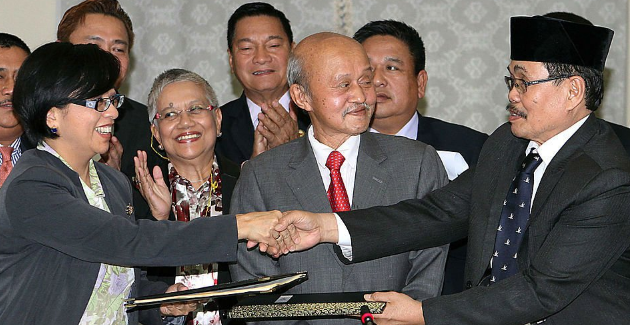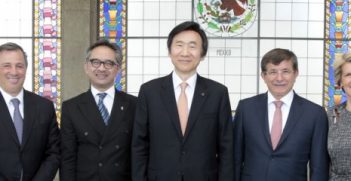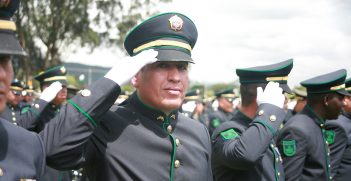Malaysia: Southeast Asian Peacemaker?

Malaysia and the Philippines are gradually overcoming historical tensions over disputed territory in Sabah. As part of their reconciliation, Malaysia has played the role of mediator in the conflict between Manila and rebels in Mindanao. Further progress in this peace process could establish Malaysia as a regional peacemaker.
The ongoing rebellion of the Muslim minority population of Mindanao (known as the Moros) remains a challenge for the Philippine government. In the past 40 years, it has resulted in 120,000 deaths and displaced hundreds of thousands of people. The conflict is a pressing security concern for regional neighbours as well as states further afield, including Australia and the US. Malaysia has an interest in resolving the conflict in Mindanao due to its proximity to Sabah in northern Borneo.
During the Cold War, there was a clash of interests between Malaysia and the Philippines over Sabah. Relations between the two countries soured after President Ferdinand Marcos passed a bill that included Sabah as part of Philippine sovereignty. Thereafter, Manila secretly backed Moro insurgents to challenge Malaysia’s claim over Sabah. In retaliation, Malaysia supported the Moro National Liberation Front (MNLF) to destabilise Manila’s rule in Mindanao.
Sources of discontent among the Muslim population of Mindanao included economic deprivation and the increasing number of Christian settlers. The main groups operating in Mindanao included the MNLF, which was largely active in the 1970s. Thereafter, the Moro Islamic Liberation Front (MILF), a breakaway faction of the MNLF led by Salamat Hashim, became the largest insurgency group in Mindanao. It was not until the 1990s that Abu Sayyaf emerged and quickly gained notoriety for kidnapping Western tourists.
Talks were brokered in the mid-1970s by the Organisation of Islamic Cooperation (OIC), which led to the Tripoli Agreement between Manila and the MNLF in 1976. In August 1977, President Marcos announced that he had dropped claims over Sabah for the sake of improving regional relations. After continued efforts through the consecutive governments of Corazon Aquino (1986–92) and Fidel Ramos (1992–98), talks in 1996 produced the Final Agreement on the Implementation of the 1976 Tripoli Agreement, which granted autonomy to the Muslim-majority areas.
While the MNLF accepted the peace deal, the MILF became the largest insurgency movement operating in Mindanao. The transnational security challenge posed by the MILF and Abu Sayyaf attracted foreign aid and security cooperation toward a peace process, especially after 9/11. Canberra and Washington have sought to suppress groups linked to Indonesian terrorist groups and al-Qaeda. Both countries have concentrated much of their efforts on strengthening the Philippine army’s counterterrorism capabilities.
However, while Western governments were directing their foreign policy initiatives in Southeast Asia against the threat of terrorism, Malaysia became the main party to facilitate the peace process in Mindanao.
Prior to Malaysia’s involvement, President Joseph Estrada (1998–2001) had embarked on an ‘all-out war’ policy in 2000, which brought an end to peace talks then being conducted without third party mediation. Once Estrada was ousted, Manila announced a unilateral ceasefire. The MILF proposed three conditions, which were accepted by Manila. These were that talks should be mediated by the OIC or one of its member states, that parties should respect past agreements and that talks should be held in a foreign country. Malaysia began its role in 2001 as mediator with the first round of talks held in Tripoli, Libya.
Since the beginning of Malaysia’s involvement, the peace process has alternated between talks and armed confrontation. Fighting broke out in 2003 when the government launched an offensive against the MILF headquarters in Maguindanao. The International Monitoring Team, led by Malaysia, was subsequently established in 2004 to monitor the ceasefire agreement. In 2008, talks were suspended again by fighting that displaced 500,000 people. Following the establishment of the International Crisis Group in 2009, negotiations resumed in 2010, achieving a breakthrough in 2012. The Framework Agreement on the Bangsamoro in October 2012 was hailed as a milestone in efforts to resolve the conflict. Malaysia’s role was recognised to have been crucial to its success.
In March 2014, the Comprehensive Agreement was signed at the Presidential Palace. But in 2016 national anger turned against the Bangsamoro Basic Law following clashes with the MILF and the Bangsamoro Islamic Freedom Fighters (a breakaway group), which led to the deaths of 44 Philippine commandos and the displacement of 148,000 people. In February 2016, Malaysia’s Prime Minister Najib Razak assured continued support for the peace process beyond Aquino’s term. Although President Duterte is a native of Mindanao and vowed to put the Mindanao conflict at the top of his agenda during his election campaign, it remains to be seen how Manila will deal with the ongoing challenges.
What has transformed these formerly contentious bilateral relations? On the one hand, Malaysia’s concern has come from security issues such as piracy and smuggling, as well as the growing threat of terrorism, such as Abu Sayyaf’s kidnapping of 21 Malaysians from Sabah in 2000. More recently, Abu Sayyaf beheaded a Malaysian national in May 2015 and took a group of Malaysian seamen hostage in April 2016. The continuing threat has prompted a meeting amongst high-level officials from Indonesia, Malaysia and the Philippines to increase security patrols in areas vulnerable to hijacking and kidnapping.
On the other hand, the influx of refugees from Mindanao is an increasing concern for Malaysia. Estimates put the number of Filipinos in Sabah somewhere between 800,000 and 1.4 million in 2013.
Most importantly, a resolution to the Mindanao conflict would incline Manila to relinquish its claims on Sabah, which is a valuable source of natural resources. The Sabah dispute has largely remained dormant, but the conflict resurfaced in 2013 when more than 100 armed Philippine men identifying themselves as members of the Royal Sulu Sultanate Army entered Sabah to reclaim their ancestral lands.
Both the Malaysian and the Philippine governments have much to gain from a peaceful resolution to the conflict in Mindanao. An end to the conflict would greatly enhance the standing of the Philippine government of the day.
With a prominent role in peace processes in Mindanao as well as Thailand’s southern border provinces, Malaysia has an opportunity to carve a place as a regional peacemaker. Should Malaysia be successful in resolving the long-standing conflicts in its neighbouring countries, this would greatly enhance Malaysia’s regional recognition for peacebuilding. So far, Malaysia has won praise for its role and the advancement of the peace deal in Mindanao, despite some scepticism and concern in Manila about Malaysia’s role as ‘an honest broker’.
The conflict in Mindanao has attracted the attention of actors outside the region. As such, Malaysia could gain recognition beyond the region. Many Western and Asian countries have focused some of their efforts in supporting the peace process in Mindanao, whether with development aid or military assistance. While the both the Mindanao and Thai border disputes are in Muslim-majority areas governed by governments of a different ethnicity and religion, Malaysia, as a moderate Muslim country and fellow ASEAN member state, could bridge the gap between the conflicting parties. Any positive developments in the Mindanao peace process would enhance Malaysia’s reputation as a regional peacemaker.
Dr Chanintira na Thalang is assistant professor in the Faculty of Political Science at Thammasat University in Bangkok.
This article is adapted from Chanintira na Thalang’s article in the Australian Journal of International Affairs, published 26 January 2017, ‘Malaysia’s role in two South-East Asian insurgencies: “an honest broker”?’. It is republished with permission.





